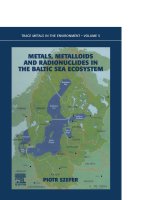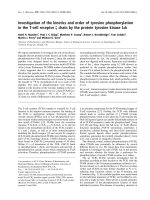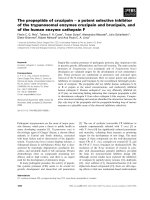The Aral Sea Encyclopedia - F ppsx
Bạn đang xem bản rút gọn của tài liệu. Xem và tải ngay bản đầy đủ của tài liệu tại đây (123.6 KB, 4 trang )
F
Farming (Historical) in the circum-Aral area – the initial demarcation of states
in the region coincided, in many cases, with irrigat ion zones and irrigation
systems, which appeared in the Aral basin in the first quarter of 1000 B.C.
This period was preceded by the large-scale unification of local tribes in 7th–6th
centuries B.C.
The most developed state in the Circum-Aral area in the 6th–4th centuries
B.C. was ancient Khorezm. There, on the territory of the Sarykamysh delta of
the Amudarya, large irrigation systems were constructed, the length of main
canals in them reaching 100–150 km, with a width of 10 to 30 m and a depth of 2
to 3 m. Plough farming was also intensively developed, applying iron agricul-
tural implements (hoes, shovels) which enormously improved labor efficiency
and enabled the population to transform desert lands into cultural oases.
The irrigation systems in ancient Khorezm were rather ramified and, in
general, their structure was as follows: river – head water intake – main canal
(arna) – primary and secondary distributory canals – irrigation ditches – field.
In the Khorezm antiquity, the following periods are distinguished: the
archaic (6th–5th centuries B.C.); the Kangyuisky; and the Kushansky (4th
century B.C.–4th century A.D.), the latter being the period when ancient
irrigation systems flourished, shaping the ‘‘Great Silk Road.’’ During this
time, the irrigated areas in the Khorezm oasis expanded enormously, the
irrigation water intake and head structures were improved significantly, water
application practices were perfected, and general irrigation schemes became
more intricat e; however, investigations have shown that only gravity irrigation
was applied in those times, so farmers were fully dependent on the hydrographic
changes of delta arms. Despite the enormous total area of irrigated lands,
covering 4.3 mln ha of the Aral basin flatlands (out of which up to 2.5 mln ha
were serviced by large irrigation systems), the land use factor did not exceed
10–12%. The lands that became saline shortly during several years of their
utilization were abandoned, which is confirmed by a small thickness (15 to
20 cm) of the irrigated layer in agricultural lands. At that time, a fallow farming
system was practiced. In the mid-1st century A.D., the process of irrigated
farming escalation in ancient Khorezm ceased due to an acute economic and
social crises.
I.S. Zonn et al., The Aral Sea Encyclopedia, DOI 10.1007/978-3-540-85088-5_7,
Ó Springer-Verlag Berlin Heidelberg 2009
95
At present, soils in the Circum-Sarykamysh area, upon which irrigation
ceased in the 5th century and which were no long irrigated as cultivated land,
are more subject to desertification and at the stage of takyr formation. The
nearby ancient delta territor y that was irrigated only from time to time (or was
not irrigated at all) is now in transit from takyr formation to deflation.
The specific feature of these landscapes is the presence of leveled, rather
lengthy sections of takyrs (see) and takyr-like soils in an area that corresponds
to the area of the ancient fields and is crossed by sandy ridges running largely in
perpendicular directions. The areas of cattle routes are characterized by a
higher sand content, greater breakdown of road edges, and nascent vegetation
successions. The territories adjoining the large waterways are affected by sub-
mersion and solonchak-formation processes.
Irrigated farming in the Lower Syrdarya originated in mid-1000 B.C.
(approximately 300 years later than in the Amudarya). Traces of primitive
irrigation and semi-nomadic horticulture-farming-fishery occupation dating
back to the bronze age have survived. At one time, basin-type irrigation was
practiced; it used flood waters regulated with the help of leveeing. Such irriga-
tion systems existed along the Kuvandarya and Zhanadarya river channels. The
following scheme of irrigation was applied: river-oxbow (reservoir) – irrigation
ditch – field. During an irrigation season, the irrigation layer of agricultural
lands, notwithstanding the periodical renewal of irrigation, didn’t have suffi-
cient time for formation, which is demonstrated by the presence of intercalating
single thin takyr-like interbeds in the profiles of post-irrigation soils.
Desertified soils in the Kuvandarya delta abandoned in mid-1000 B.C. are at
the takyr-forming stage at present, which coincides with the period of general
aridization of this territory. Landscapes with dominating takyrs and takyr-like
soils and fragmentary sandy soils interchange with areas of drifting sands and
sandy broken takyrs in the cattle grazing zones.
Up until to the 8th century, the Khorezm oasis was in decay – irrigation
systems were not operational and became dilapidated. During the Afrigid
dynasty, farming was of a spot nature. In the 8th century, however, elements
of the ancient irrigation systems were used for occasiona l irrigation.
Extensive irrigation construction began again in the 11th century. The
organization of irrigation was radically transformed and permanent irrigation
emerged. On the main Amudarya channel head structures (saka), main canals
(arna), large distributory canals (yab), secondary aryks, chigir pits, and Persian
wheels (chigirs) were constructed. Chigir water-lift irrigation or ‘‘Persian wheel’’
made possible the delivery of irrigation water to the uplands to increase the
irrigated areas and enhance the land use factor by up to 30–40%.
Irrigation systems developed in the Middle Ages were, of course, more
efficient than ancient ones; a complete lack of a collection-drainage network,
however, made it actually impossible to control secondary salinization.
At the same time, farmers applied various local land reclamation practices
(sand application, loosening, fertilizer application) that, together with silt
96 F Farming (Historical) in the circum-Aral area
deposition, facilitated formation of thicker agricultural irrigation layers (up
to 50 cm).
The con quests of Genghiz Khan and his sons and the ruinous wars of Timur
(13th–15th centuries), confirmed by the results of archeological and topogra-
phical investigations of the Khorezm expedition in the 1930s, led to irrigation
decay in Khorezm in the 13th century. The post-irrigation landscapes aban-
doned in those times have evolved at present to a stage of takyr formation.
The main occupation of the population in the Syrdarya lower reaches, which
in the 12th–13th centuries belonged to Khorezm, was cattle breeding.
Farming was of a spot (non-regular) nature. Irrigation systems were primi-
tive and, as in ancient times, they used flood waters. Irrigation was practiced
mostly on submerged near-channel territories. Permanently irrigated areas were
found along Zhanadarya, Inkadarya, and, partially, Kuvandarya, and they
covered in total 700–800 thou ha. The area of intermittent irrigation was 400
to 500 thou ha.
Massifs of takyr and takyr-like soils has formed in the Zhanadarya delta in
place of irrigation systems abandoned in the 13th century. They alternate in the
landscape with the territories used for intensive grazing, are distinguished by a
high sand content and the availability of multiple deflation sources.
The total area occupied by medieval irrigation systems in the delta plains of
the Amudarya and Syrdarya lower reaches is approximately 1 mln ha.
In the post-Mongolian time and up to the early 20th century, irrigated
farming developed in separate localities, covered small areas, and was practiced
largely in the deltas of main channels of the Amudarya and Syrdarya Rivers.
The lands in the Circum-Aral delta that were abandoned in the 15th–18th
centuries and turned into deserts are at present in transition from aridization
to takyr-formation.
In the 19th–20th centuries and today, the desertif ied territories of the ancient
delta plains are used as pastures.
Films about Aral – The early period the A.S. drying and the emergence of related
problems, such as water pollution; dust and salt drift; loss of biodiversity and
resultant unemployment; growing death rate among the adult population and
children; etc. stirred great anxiety and, at the same time, the interest of the wider
public. Film-makers from many countries could not avoid this environmental
disaster. Thus, in 1995, the American producer, Christopher Hooke, made a
14 minute documentary film, ‘‘Women of the Aral.’’ The film was shot in the
former fishery port of Aralsk, Kazakhstan, where fishermen were left without
work, and the women were forced to take up the burden of survival, organizing
a cooperative for tailoring garments and making carpets from camel, goat, and
sheep fur.
In 2000, Turkish cinematographers (‘‘Academi Production’’), with the sup-
port of the former chairman of the Soviet-Turkish Council on Business Coop-
eration (Nikhat Gekyingit, 1988–1998), made a documentary called ‘‘Aral’’
(producer Kemal Uzun) about the environmental disaster in the region.
Films about Aral F 97
Leading Russian scientists N.F. Glazovsky (see), I.S. Zonn, N.V. Aladin, and
D.Ya. Ratkovich took part in this film with their commentary.
In 2004, Dutch producer Jakob Gotteschau shot a 29 minute film called
‘‘Predictable Catastrophe: the Aral Sea’’ (Late Lessons from Early Warnings).
In the same year, one more film, ‘‘Aral, Fishing in an Invisible Sea’’ (52 minutes),
was made by Uzbek and Italian p roducers Saodat Is mailova and C arlos Casas.
This film tells abo ut the fate of t hree generations of one family of fishermen living
near what remains of the Aral.
In 2005, the film ‘‘Killing the Aral Sea: Catastrophe by Design’’ was made.
One more film about the Aral called ‘‘The Poisoned Land, the Dying Sea’’
was awarded the prize for Full-Length Films and TV Films at the Monte-Carlo
International Festival.
Fisherman of the Aral – newspaper published in the 1960s in Karakalpakia.
Fisheries on the Aral Sea – the history of fisheries in the lower reaches of the
Amudarya goes as far back as the Neolithic tribes of primeval hunters and
fishermen. Archeological excavations of the encampments of the peoples of the
ancient Khorezm prove the existence of an ancient fishery. Later, it was identi-
fied that the bones found in the Djambaskal encampment 60 km to the north–
east of Turtkul belonged to several fish species, mostly pike and common carp.
In excavations of other settlements in the lower reaches of the Amudarya from
the period of the flourishing of ancient Khorezm (3rd century A.D.–11th
century) fish remnants belonging to 5 fish families were found. The species of
fish that were caught by the people in ancient Khorezm wer e similar to those of
the present – bastard sturgeon, roach, rudd, Turkestan barbell, asp, and others.
The people of ancient Khorezm caught fish in rivers and lakes. Such mixed
fisheries (lake-river) existed until the present day.
After the downfall of Khorezm and up until the establishment of regular
relations between the Khiva Khanate and Russia, the fishery in A.S. developed
very slowly because of the difficulty of commercial distribution. The signifi-
cance of commercial fisheries on the A.S. was not high (about 5% of USSR
fishery); however, in catches of such valuable fish as bream, common carp, pike
perch, barbell, and others, the basin took the first place in the USSR. The share
of catches of these fish species in A.S. was as high as 93% of the total catch,
while the shares of the Caspian and Azov Seas were 18% and 9%, respectively.
While in the period of the optimal sea regime (1958–1960), the fish catches in the
basin were maintained at 46 thou tons, already by the late 1970s, they were only
6.7 thou ton s and in early 1980 the total catch dropped to 1 thou tons. By this
time, the share of valuable fish species dropped sharply. At present (2008) there
are no fisheries on the Large Aral Sea.
98 F Fisherman of the Aral









